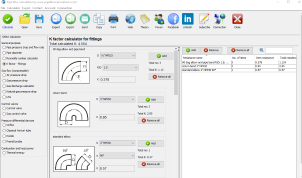
Air flow calculator
calculation of air flow and pressure drop
online since 2007
Calculator start selection
Read all about available deployments. In any way of utilizing calculator, Internet connection is not required, but nice to have for authentication at least.
Available in download version
save/open multiple resultsexport to word and excel
print results
common and custom fluid properties
K factor for fittings, resistance coefficient
pipe surface roughness selection
pipe material selection
select between gauge and absolute pressure
compressible isothermal flow
dry air isothermal flow
gas offtake flow
natural gas flow
Administrator role not needed to install calculator
When is this calculator suitable?
You can use this calculator to calculate air flow through a pipeline or to calculate a drop in air pressure when flowing through a pipeline. The calculation of air flow and pressure drop is applicable for round cross-section pipelines for both laminar and turbulent flows.
What are the calculator restrictions?
The calculator assumes that the temperature of the air flowing through the pipeline is constant, regardless of the pressure drop. This assumption is true only if the pipeline is relatively long, without significant and sudden changes in most cross sections, and for pipelines without thermal insulation.
In the case of a slow, stationary flow of air through the pipeline, the drop in temperature that would otherwise result from the pressure drop is compensated by the heat transfer from the pipeline environment. The heat thus taken from the environment keeps the air temperature in the pipeline itself constant.
How is the calculation executed?
The calculator uses the isothermal flow equation of the perfect gas to calculate the pressure drop.
To calculate the pressure drop, the calculator calculates the coefficient of friction (f) as well as the coefficient of local resistance (K).
Also, the calculator calculates the mean air velocity at the beginning and end of the pipeline.
The calculation involves calculating the Reynolds number (Re).
Calculator presents values of Reynolds number and flow regime - laminar or turbulent, as well as calculated velocities on the pipe start and the pipe end.
When is this calculator not relevant?
This calculator cannot be used for adiabatic flows when the temperature of the air flowing through the pipeline changes due to pressure drop.
This means that you cannot use this calculator for streams where you expect a significant drop in pressure, such as flow through narrow openings, high-speed atmospheric leaks, and the like.
The calculator does not take into account the change in altitude, that is, it does not take into account the influence of the Earth's gravity due to the fact that the air density is relatively small and the potential energy of the position is, as a rule, significantly lower than the pressure energy, or the kinetic energy of the air stream.
What else has to be known to perform the calculation?
To calculate the pressure drop, it is necessary to enter the air flow rate.
To calculate the air flow rate, it is necessary to enter the expected pressure drop.
Watch how calculator can help you resolve task in less than a minute
Example #4
Task: Calculate the pressure drop generated by the air at a flow rate of 500 m3 / h through a pipe with an inside diameter of 60 mm and a length of 100 m. The air temperature is 5 C, the roughness of the pipeline is 0.02 mm, and the coefficient of local resistances is equal to zero - there are no local resistances in the pipeline. Pressure on the pipeline start is 4 bar gauge.
Solution: Pressure drop is: 95.67 mbar
Example #5
Task: Calculate the air flow through a pipe with an inside diameter of 1 inch and a length of 200 m. The available pressure in the air tank from which the pipeline starts is 2 bar gauge. At the end of the pipeline, the air flows out into the atmosphere. The internal roughness of the pipe wall is 0.1 mm. The pipeline has 6 pipe elbows 90 degrees and a radius of 1.5 D. The air temperature is 15 C.
Solution: Flow rate is: 90.713 m3/h
Example #6
Task: Calculate the pressure drop that creates air at a flow rate of 1000 cfh through a pipeline with an inside diameter of ½“, and a length of 1000 ft, with an internal roughness of the pipe wall of 0.012 in. The pipeline has 4 elbows 90 degrees and one reduction at the end of the pipeline to ¼“, after which the air flows into the open atmosphere.
Solution: Pressure drop is: 7.287 bar




